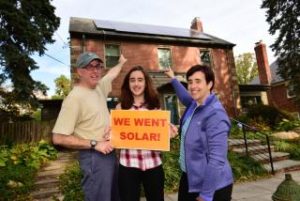Calculating the “Value of Solar” in the District of Columbia
 A common question from prospective solar buyers is “how much will I get for the electricity my system produces?” In most places, this is determined by net metering. As the name implies, people who have solar only pay for the ‘net’ electricity they use from the utility. When solar customers’ systems are producing more electricity than their home uses, their meter runs backwards. Last year saw fights in more than two-dozen states over how solar customers should be compensated for the electricity they generated. Net metering is an easy to measure, but nonetheless crude, metric for measuring the actual value of the solar being generated. Battles over net metering have encouraged regulators to examine different solar compensation models.
A common question from prospective solar buyers is “how much will I get for the electricity my system produces?” In most places, this is determined by net metering. As the name implies, people who have solar only pay for the ‘net’ electricity they use from the utility. When solar customers’ systems are producing more electricity than their home uses, their meter runs backwards. Last year saw fights in more than two-dozen states over how solar customers should be compensated for the electricity they generated. Net metering is an easy to measure, but nonetheless crude, metric for measuring the actual value of the solar being generated. Battles over net metering have encouraged regulators to examine different solar compensation models.
In order to develop a more accurate assessment, many states have begun to develop detailed “Value of Solar” studies. Washington D.C.’s Office of People’s Council has hired Synapse Energy Economics to do a study to calculate the value of solar in the District of Columbia. The company recently held a webinar to review the methodology it will use to determine how to calculate such a value.
The methodology used in these calculations is important because the inputs used in the study will shape what result it provides. For advocates trying to wrap their heads around the “Value of Solar” methodology the Synapse study is a good example of the types of things that are considered when determine the “fair” price to compensate solar households for the energy they produce. Often solar critics accuse solar producers of “free riding” on the grid or not paying their fair share. The Value of Solar approach tries to capture not only the costs to the system—but the many diverse benefits that solar brings—not only to the homeowners that invest in it, but to the grid at large. Ultimately solar homeowners want a grid that is better for everybody. Value of Solar may be a helpful tool to measure if we are making progress in that direction.
Synapse defines the Value of Solar (VoS) as the expected net benefit (or cost) that a solar installation provides to society over many years, relative to what would have happened otherwise. Community and customer sited solar are included. Potential benefits and costs to solar generators, all utility customers, the utilities themselves, and society as a whole are included as well.
In the webinar, Synapse describes 14 different metrics it will use to determine how to calculate the value of solar in the District. These metrics can be grouped into two categories: costs of adding solar, and benefits of adding solar. These are listed below.
| Costs | Benefits |
| Utility integration and interconnection |
Avoided energy use costs |
| Utility administration | Avoided transmission losses |
| Ancillary services | Avoided additional transmission capacity |
| Distribution capacity | Avoided additional generation capacity |
| RPS compliance | |
| Clean Power Plan compliance | |
| Lower energy prices due to demand reduction | |
| Fuel price hedging | |
| Lower power outage rates | |
| Carbon savings |
The firm is currently gathering all the data necessary from each of the above categories in order to calculate the value of solar in the District. The firm is in the early stages of its research and is accepting input into its study. It remains to be seen what impact the study will have and how the District will use the results. Nevertheless, this study will serve as an important data point in the fight over fair compensation for solar users.
You can watch the full webinar here.
